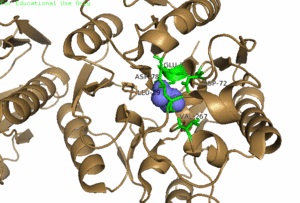This is a default text for your page Kaitlyn Enderle/Sandbox 1. Click above on edit this page to modify. Be careful with the < and > signs.
You may include any references to papers as in: the use of JSmol in Proteopedia [1] or to the article describing Jmol [2] to the rescue.
DDAH in complex with
DDAH with water pore shown
Function
DDAH in complex with
Disease
Relevance
DDAH works to hydrolyze MMA and ADMA. Both MMA and ADMA competitively inhibit NO synthesis by inhibiting Nitric Oxide Synthase (NOS). Because NO is highly toxic, freely diffusible across membranes, and its radical form is fairly reactive, cells must maintain a large control on concentrations by regulating NOS activity and the activity of enzymes such as DDAH that have an indirect effect of the concentration of NO. An imbalance of NO contributes to several diseases. Low NO levels, potentially caused by low DDAH activity and therefore high MMA and ADMA concentrations, have been implicated with diseases such as uremia, chronic heart failure, atherosclerosis, and hyperhomocysteinemia. High levels of NO have been involved with diseases such as septic shock, migraine, inflammation, and neurodegenerative disorders. Because of the effects on NO levels and known inhibitors to DDAH, regulation of DDAH may be an effective way to regulate NO levels therefore treating the diseases.
Structural highlights
Inhibitors
Zinc at pH 6.3
Zinc at pH 9
L-citrulline, L-homocysteine, and S-nitroso-L-homocysteine
L-homocysteine and L-citrulline bind in the active site in the same orientation to create the same intermolecular bonds between it and DDAH. L-citrulline is a product of DDAH hydrolyzing ADMA and MMA, suggesting DDAH activity creates a negative feedback look on itself. Both molecules enter the active site and cause DDAH to be in its closed lid formation. The αC on either molecule creates three salt bridges with DDAH: two with the guanidine group of Arg144 and one with the guanidine group Arg97. The molecules are stabilized in the active site by H-bonds: αC-amino group of the ligand to main chain carbonyls of Val267 and Leu29. Side chains of Asp78 and Glu77 with the ureido group of L-citrulline
Like L-homocysteine and L-citrulline, S-nitroso-L-homocysteine binds and the lid region of DDAH is closed. When DDAH reacts with S-nitroso-L-homocysteine, a covalent product, N-thiosulfximide exist in the active site. N-thiosulfximide is stabilized by several salt bridges and H-bonds. Arg144 and Arg97 stabilize the αC-carbonyl group via salt bridges, and Leu29, Val267, and Asp72 stabilize the Cα-amino group.
This is a sample scene created with SAT to by Group, and another to make of the protein. You can make your own scenes on SAT starting from scratch or loading and editing one of these sample scenes.

